October 26, 2021
Some do politics; I prefer the Tolbachiks!
Onward – down the volcanic spine of the Kamchatka peninsula…
Next stop volcano – Tolbachik, similarly A-list just like Klyuschevskaya Sopka, Avachinsky (near Petropavlovsk-Kamchatsky), and Khodutka and Ilynsky in the south. I’ve been all around it, up and down and across it on five occasions, and it’s always one of two things – OMG-beautiful, or an OMG-ruthlessly harsh experience (due to the weather). It’s like… Russian roulette – will you actually see Tolbachik in all its grandiose glory, or will you see… not much besides fog and rain (aka – Kamchatkan mirages), and fairly freeze while you’re at it.
I’ve been to the very top of Tolbachik tree times out of my five visits, but more on that later. For now, some photos of this distinctive, magnificent, monumental volcano:
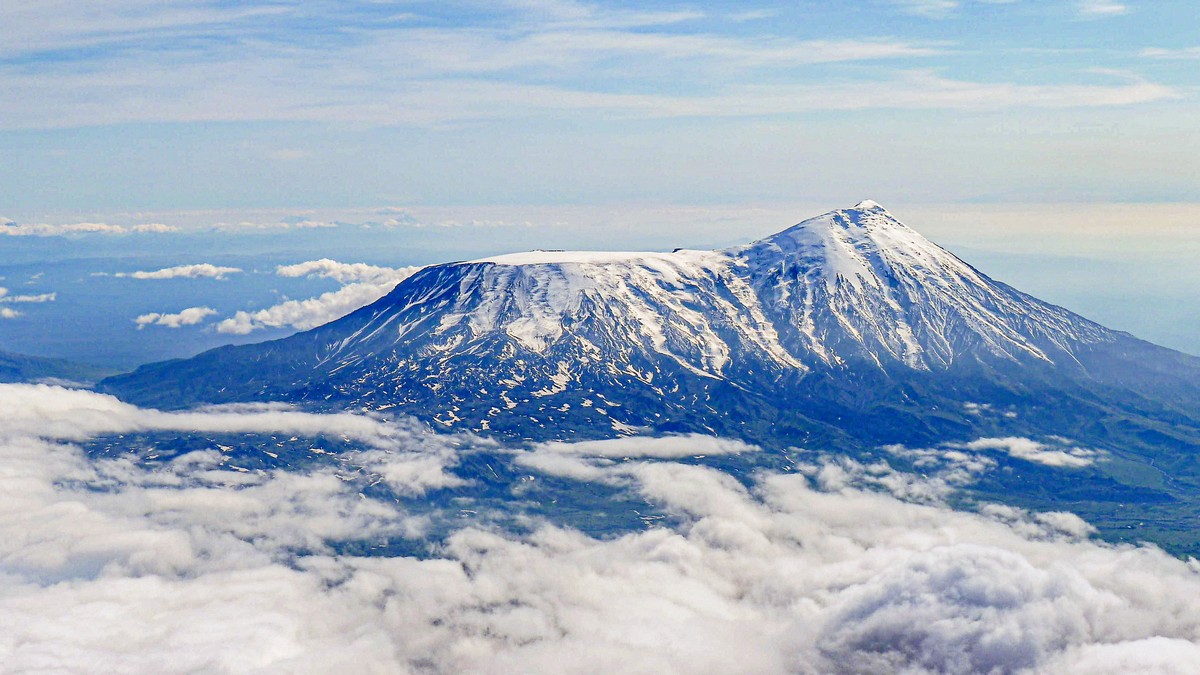
Here’s the view from the south. This year, we were headed in that (northerly) direction…

Because it’s so massive, only photos of Tolbachik taken from a helicopter can fit it all in. That is, of course, if it’s good weather (if bad weather – going anywhere near a helicopter is a bad idea).
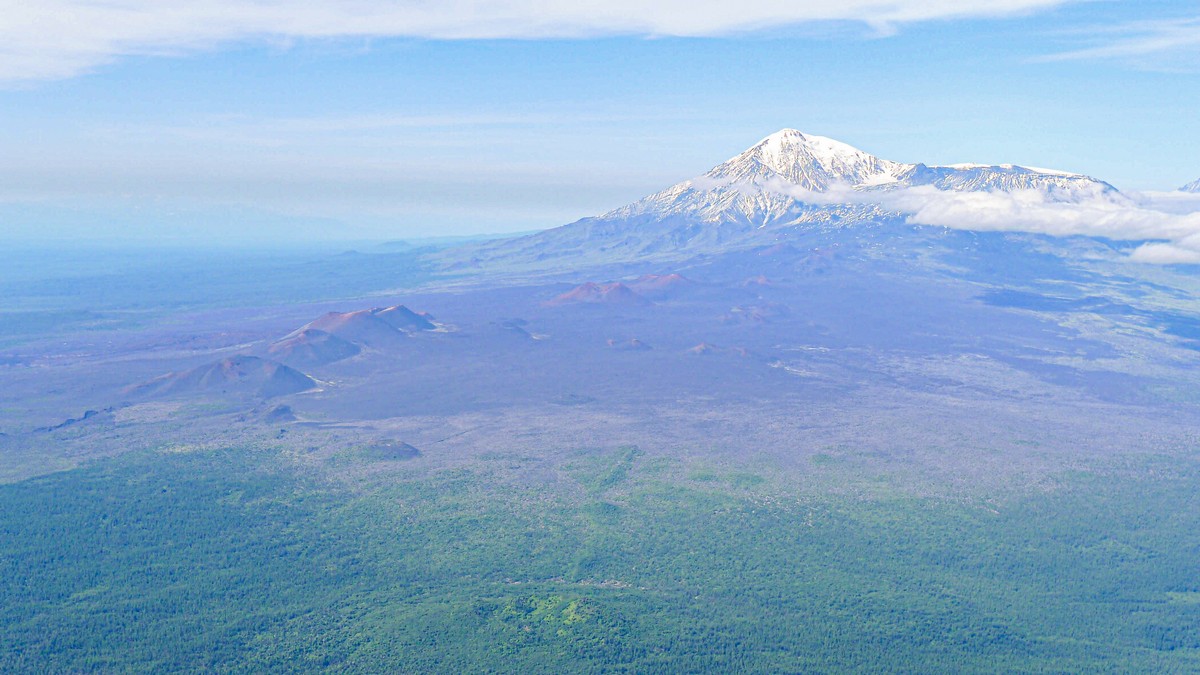
Now, since it’s so massive and therefore takes considerable time and effort to climb, why do tourists – albeit only those of an adventurous nature – even think about doing it? Well, three reasons…
First – travel agencies seem to often feature it in their proffered tour itineraries. Exactly why, I’m not sure. Could be several factors, including the third one, here, below.
Second – I keep taking ‘tourists of an adventurous nature’ there! And then I tell you, dear readers, all about it and show you lots of photos I take.
Third – as mentioned, it’s another top-tier Kamchatkan volcano, which really must be seen to be believed. Monumental, immense, meditative, fantastic; and featuring various volcanisms up top to satisfy the most discerning of volcano fans. Example:
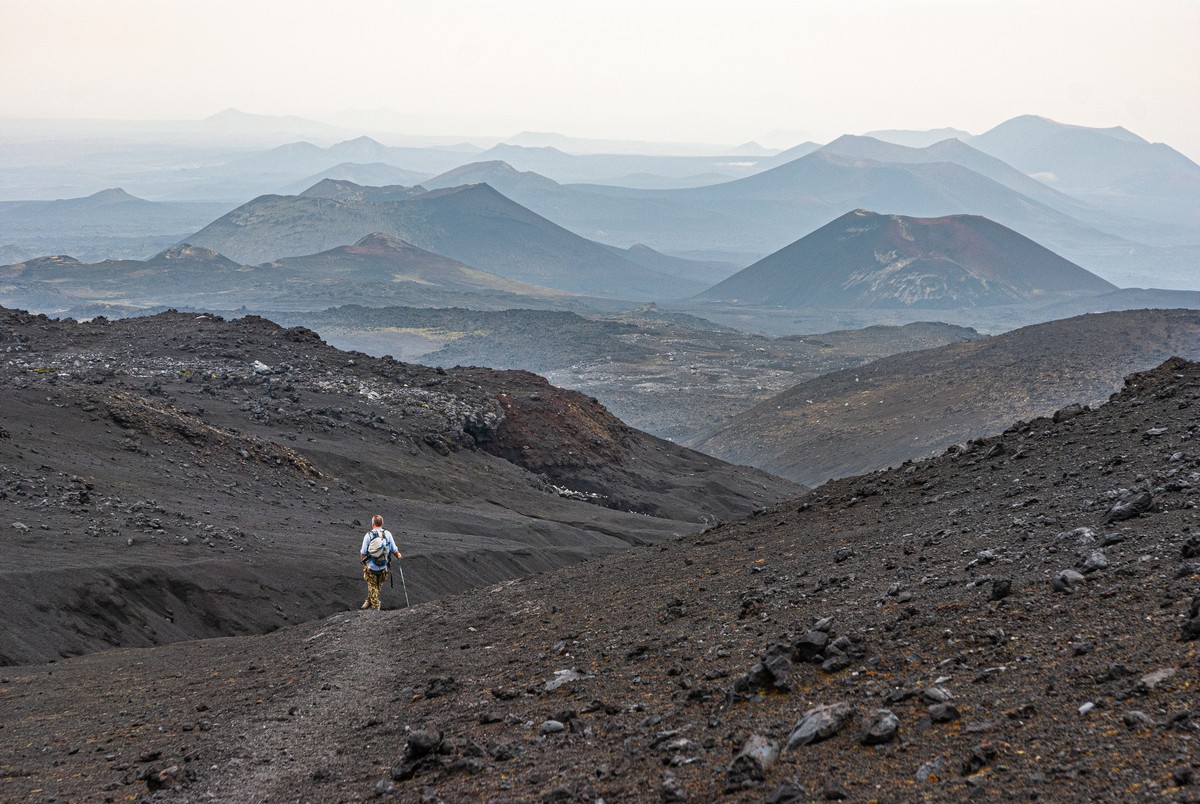
Volcanic ‘bombs’ ->
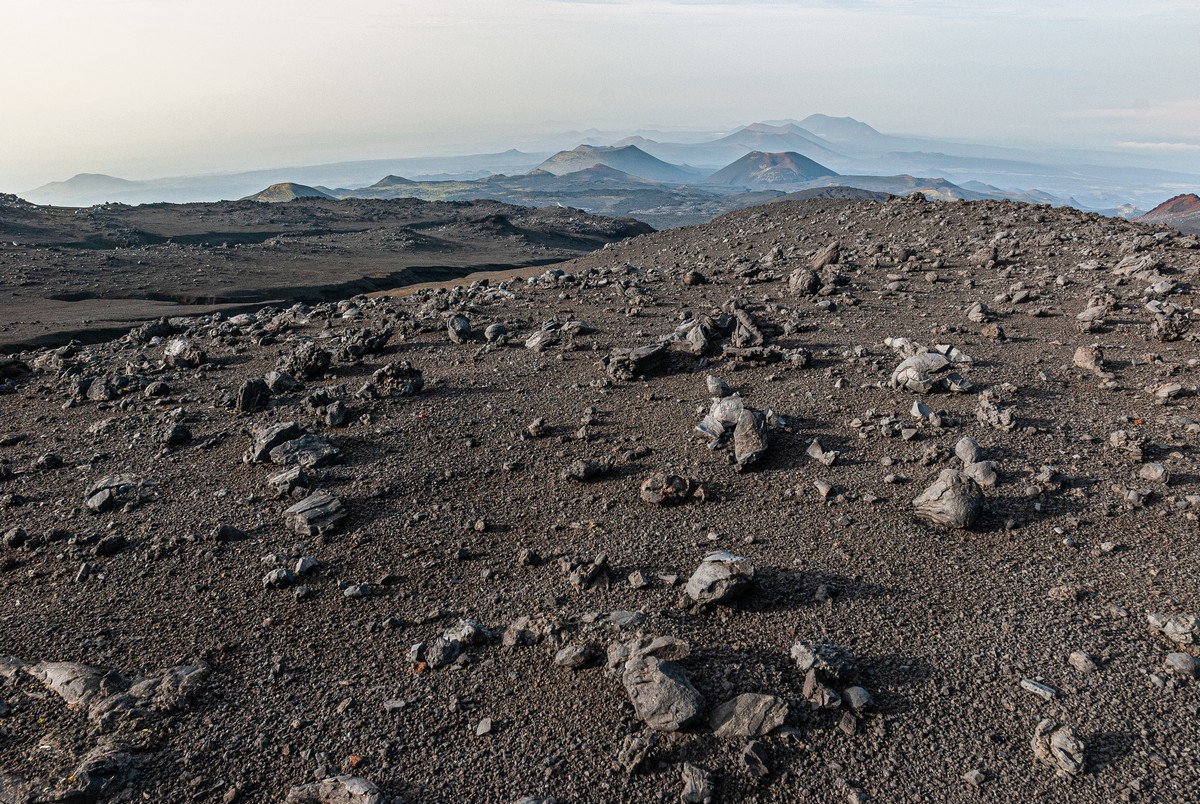
And changing landscapes. For example, this paysage doesn’t exist any more. But more about that later ->

There are actually two Tolbachiks – Ostry (sharp) and Plosky (flat). Guess which is which:

// Btw: I forgot to mention that, since there wasn’t much by the way of good weather this year, I didn’t take many photos this time. Accordingly, in this post quite a few pics are those taken by my travel companions.
Ostry – sharp – Tolbachik is a toughie, and requires serious training. While Plosky – flat – Tolbachik can be conquered by practically anyone (at least in summer or early fall) who’s reasonably fit. You do need to climb a full kilometer up the vertical, but the boots of previous tourists have trodden a solid, smooth path that’s plain sailing trekking all the way with no surprises. All you need are several hours: you walk up the steady slope, mill about at the top for a while, and then walk back down. Done and (volcanic) dusted!

In my tales from the Kamchatkan side, I often mention ‘good weather’ as being a prerequisite for positive experiences on the peninsula. Well here at Tolbachik, good weather is categorically mandatory. Though hiking up Flat Tolbachik is a cake path-walk, if clouds form before lunch then up top there’ll be nothing to see whatsoever, or just the occasional glimpse of the volcanic wonders in between clouds, which is how it was for me on my first two visits. Only on my third go was the weather nice and sunny, but oooh was it worth the wait! A deep crater around one-and-a-half kilometers across: oh my grandiose ->
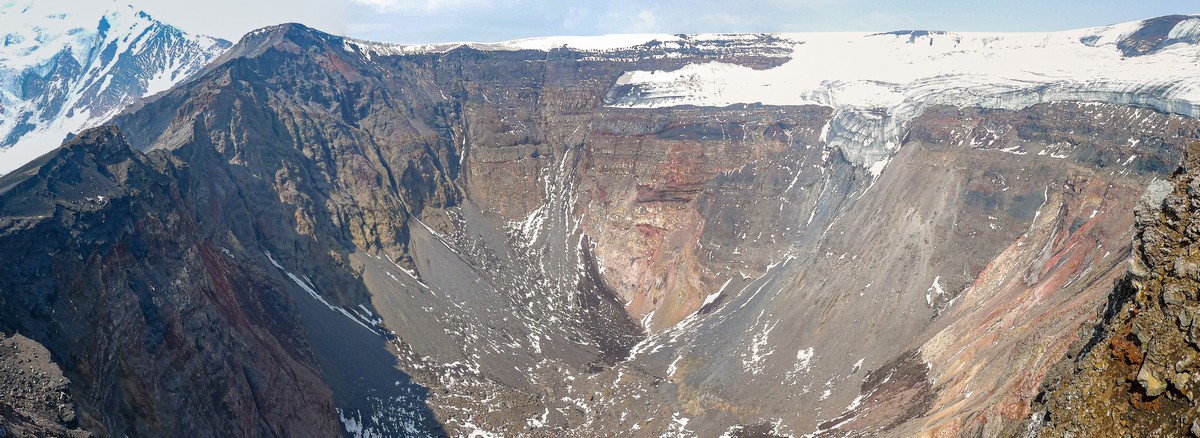
Homo sapiens – mere midges against a backdrop so gigantic…
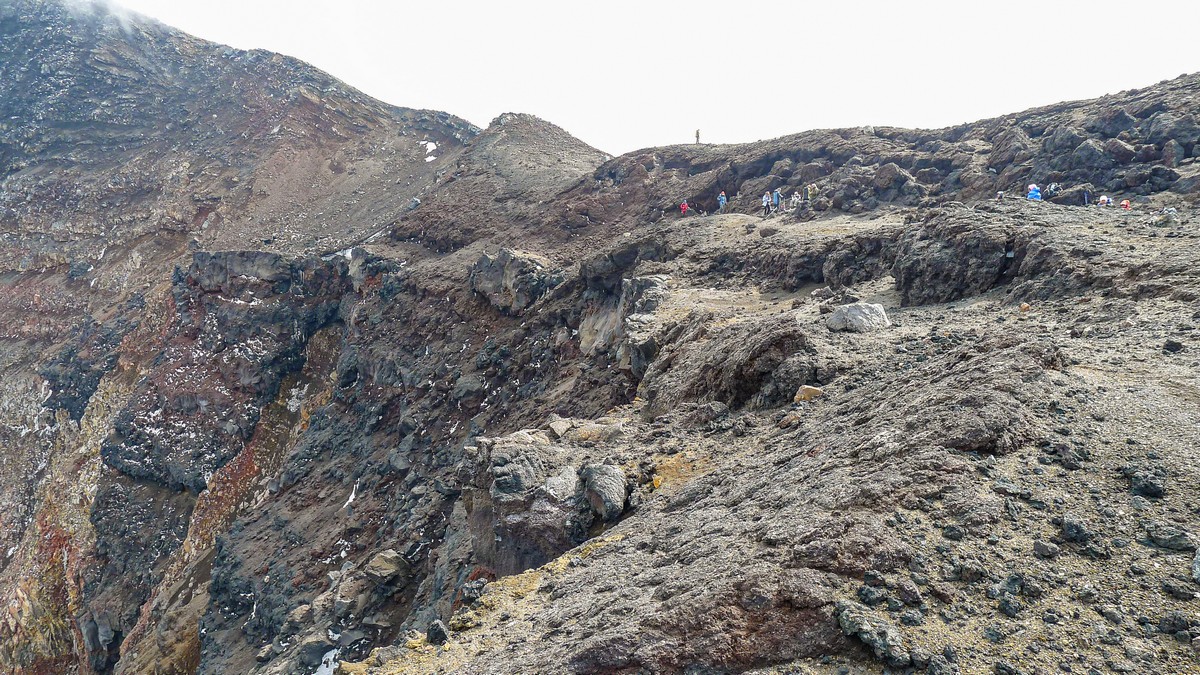
If you’re really lucky with the weather you can climb up even further – to the very top of Flat Tolbachik:
A few more photos. Just look at this one – taken from the slopes of Tolbachik. Literally a sea of volcanoes as far as the eye can see. I liked this pic so much it was my desktop wallpaper for years ->

That’s me in the photo. It was taken by A.S. – back then my constant travel companion.
Tolbachik from Bezymianny volcano:
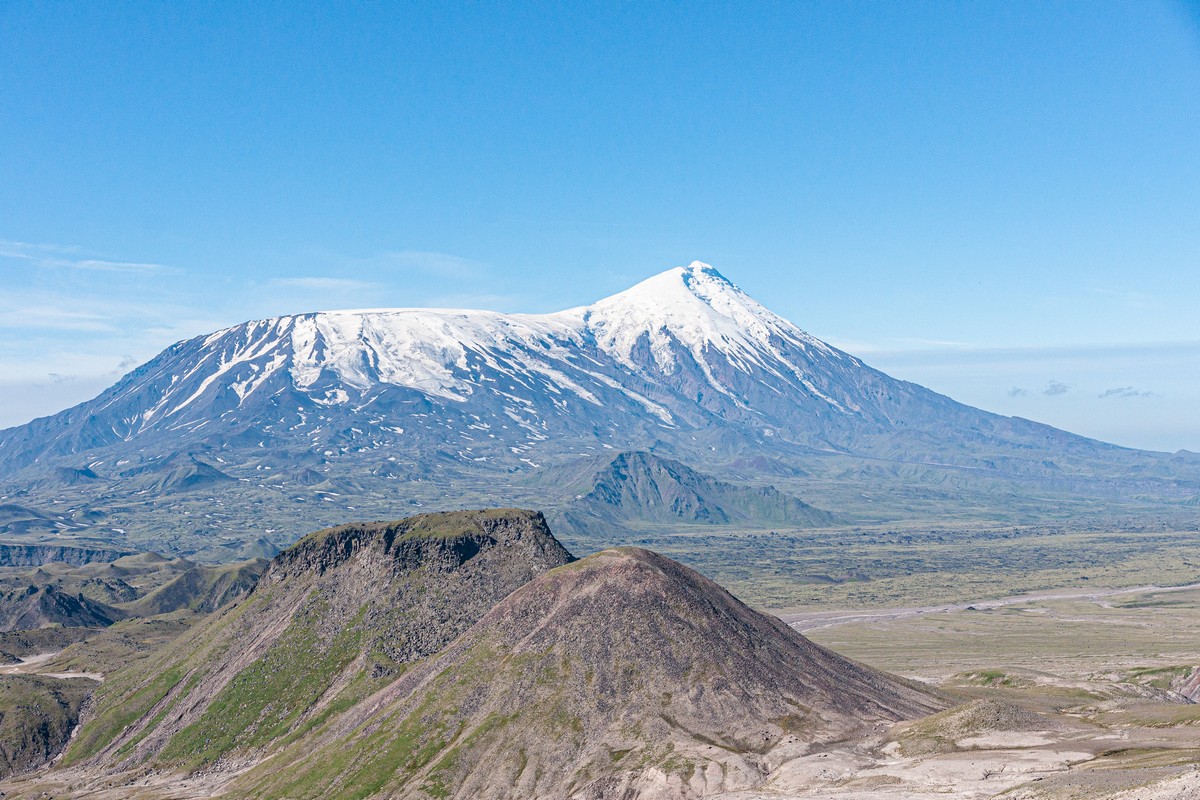
Tourists on the crater’s edge:
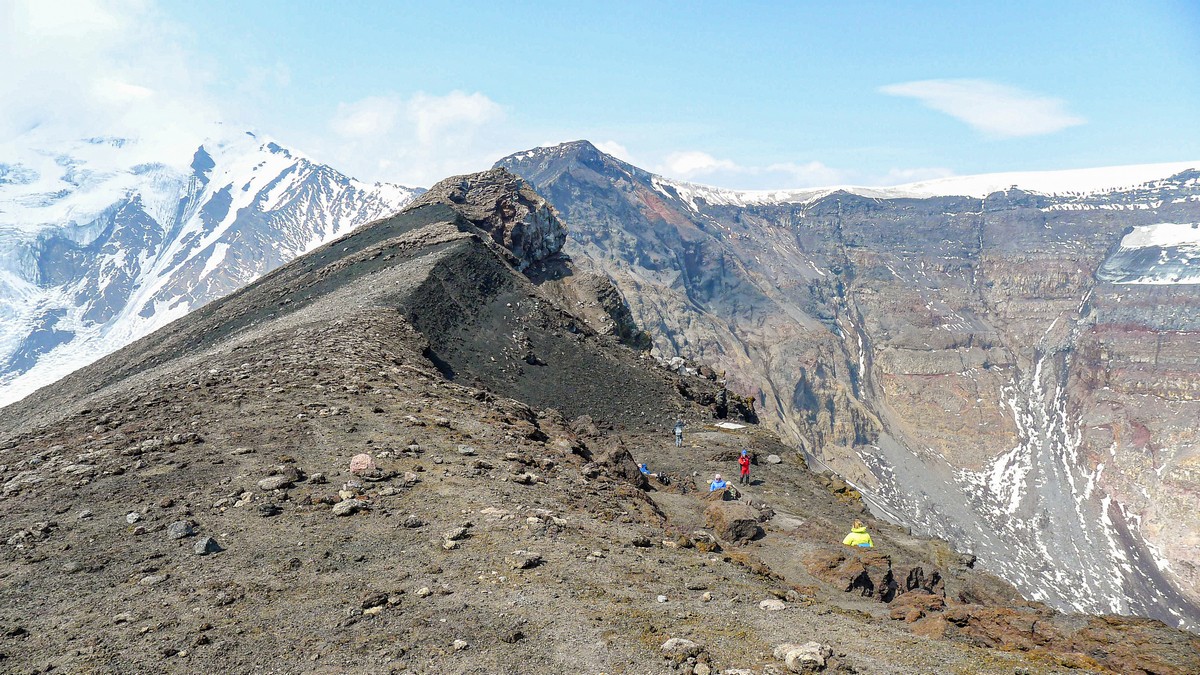
The path to the top sometimes takes you over snow caves (and I said ‘no surprises’?:)
Spectacular scenes!
Next up: fields of lava and slag – left over from many an eruption down the millennia. The internet states that Tolbachik was formed more than 10,000 years ago, with eruptions tending to occur every 30–50 years or so. Accordingly, the landscapes here don’t last long. For example, this here beaut isn’t there any more; in its place – a different beaut:

The landscapes here are totally Martian. The Soviets even tested their first lunar rover here. And they were right in doing so, because, later, after it had driven around on the moon, the official report stated ~’the area around Tolbachik has a surface with a 96% likeness to that of the moon’!
These wooden huts were installed for the moon buggy testing in the 1960s. Later on they were used by visiting adventure-tourists. Collectively they’re called the ‘Leningrad Base’! ->
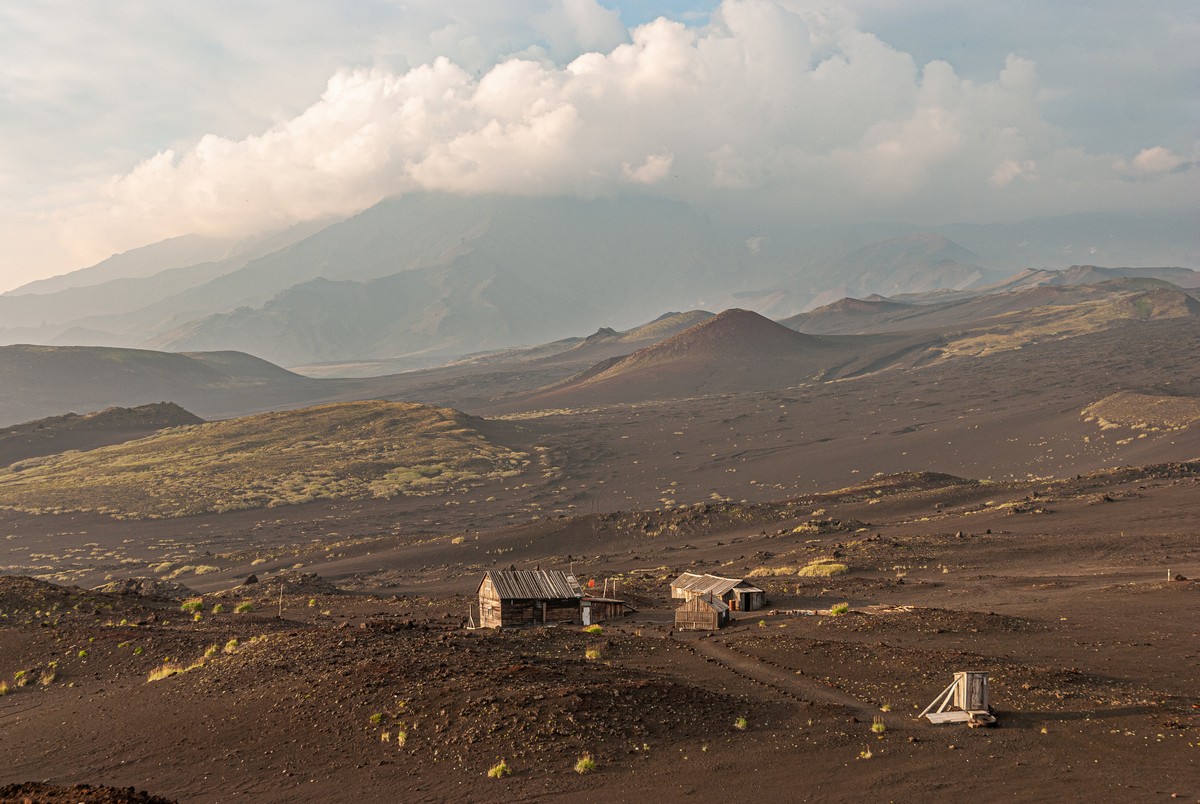
We stayed there in 2010:
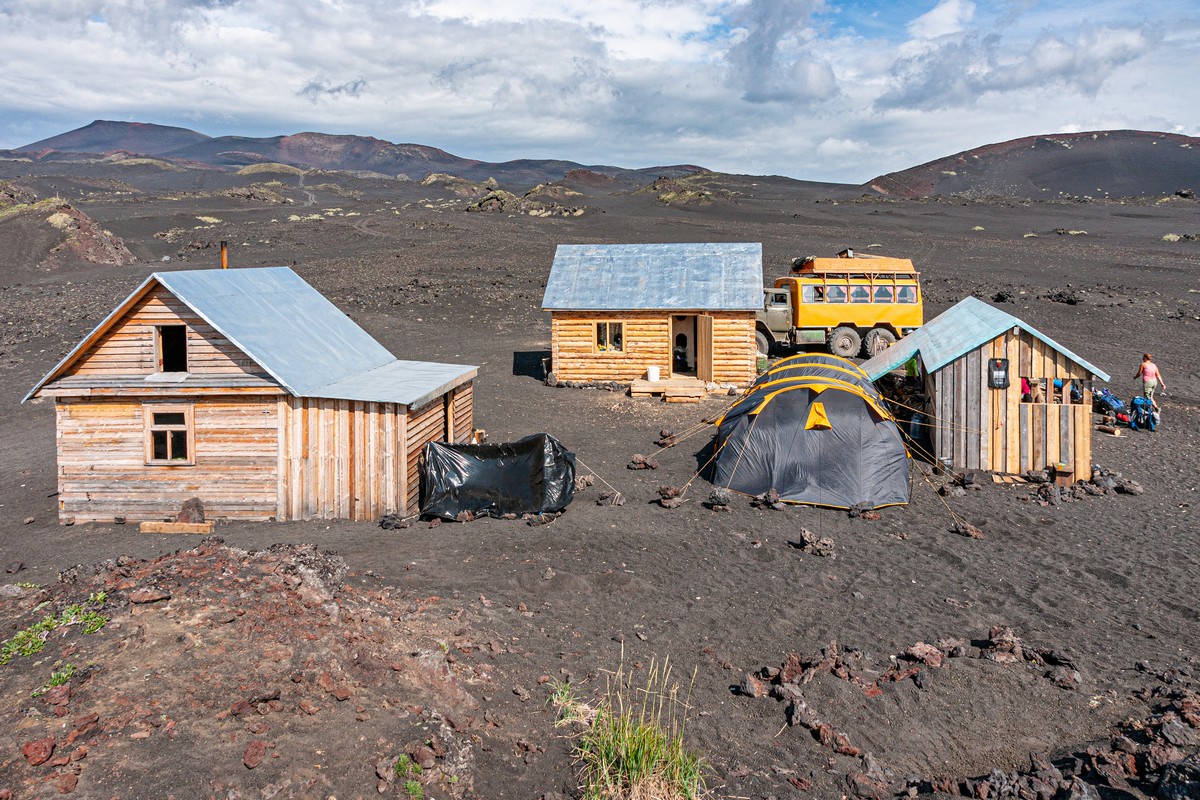
Alas, since the eruption of 2012-13, things look a lot different around here – after lava flowed all over these parts…

And the Leningrad Base ceased to exist. Indeed, life next to an active volcano is risky. Especially if you’re real estate ).

I couldn’t resist… This pair: rather becoming against the Martian backdrop! ->
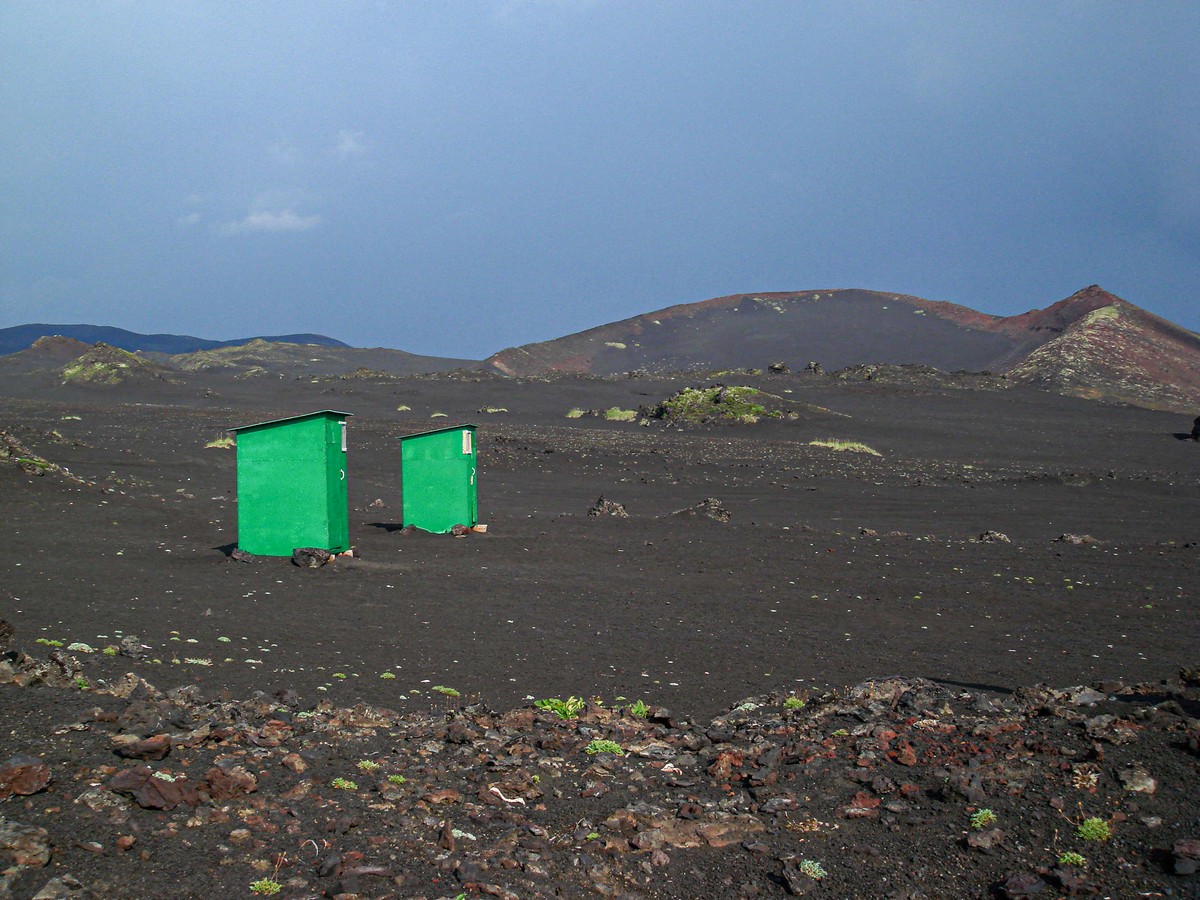
It would be interesting to see how this area looks now. In good weather, that is. In poor weather, you can’t see a thing, besides (as already mentioned) Kamchatkan Mirages ).

But when the sun’s out and there’s a blue sky – especially in summer – you can sit and meditate upon the scene forever…
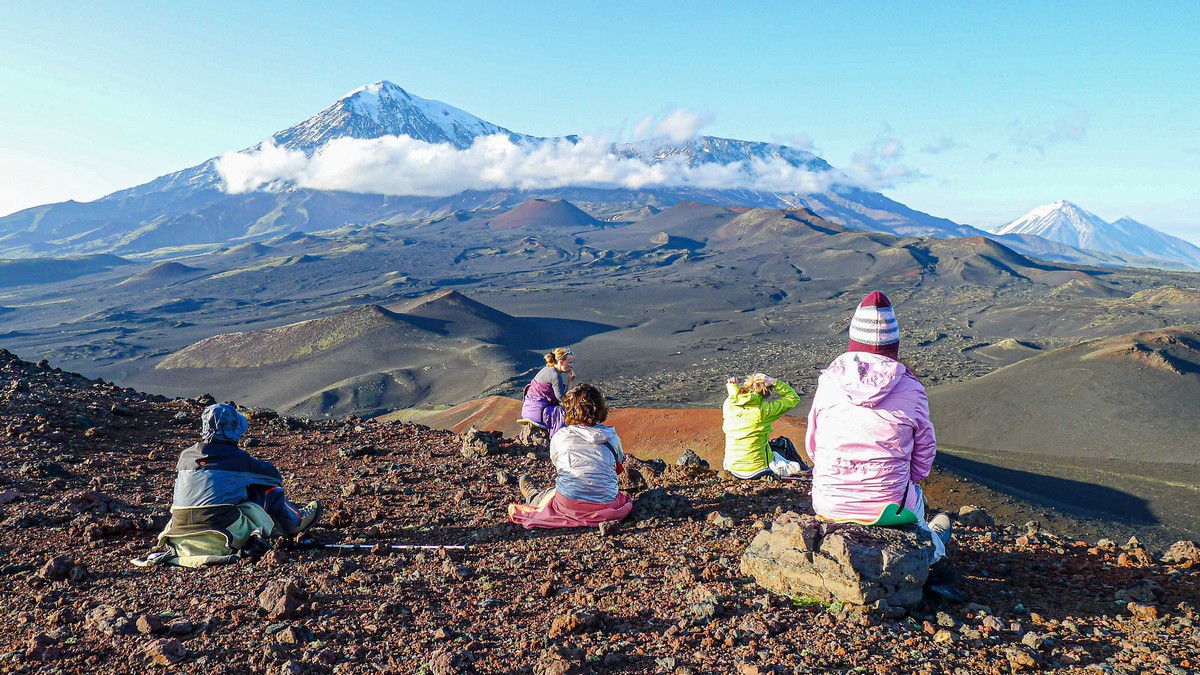
A few more photos taken by my travel companions:
Let me remind you: these scenes don’t exist anymore. In their place, altered ones.
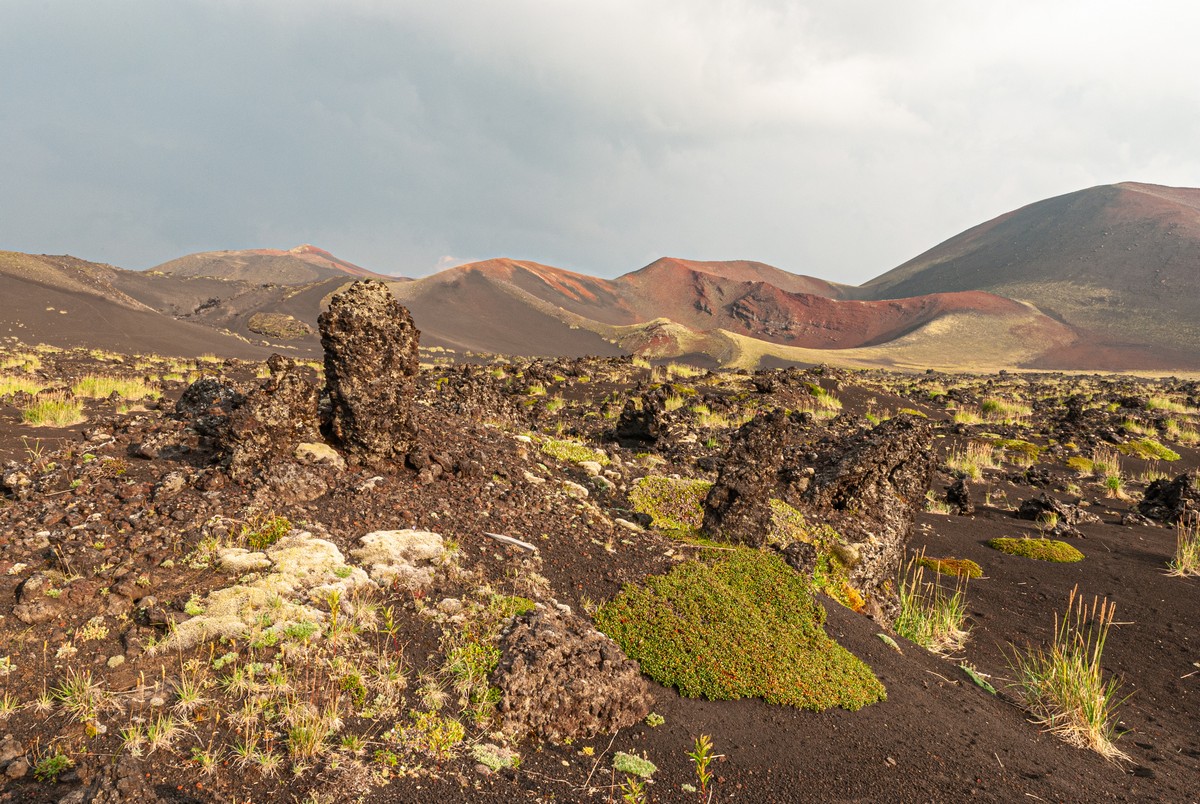
Like I say, these landscapes changed in 2012–13, when a side crater erupted and spewed… this stuff! ->
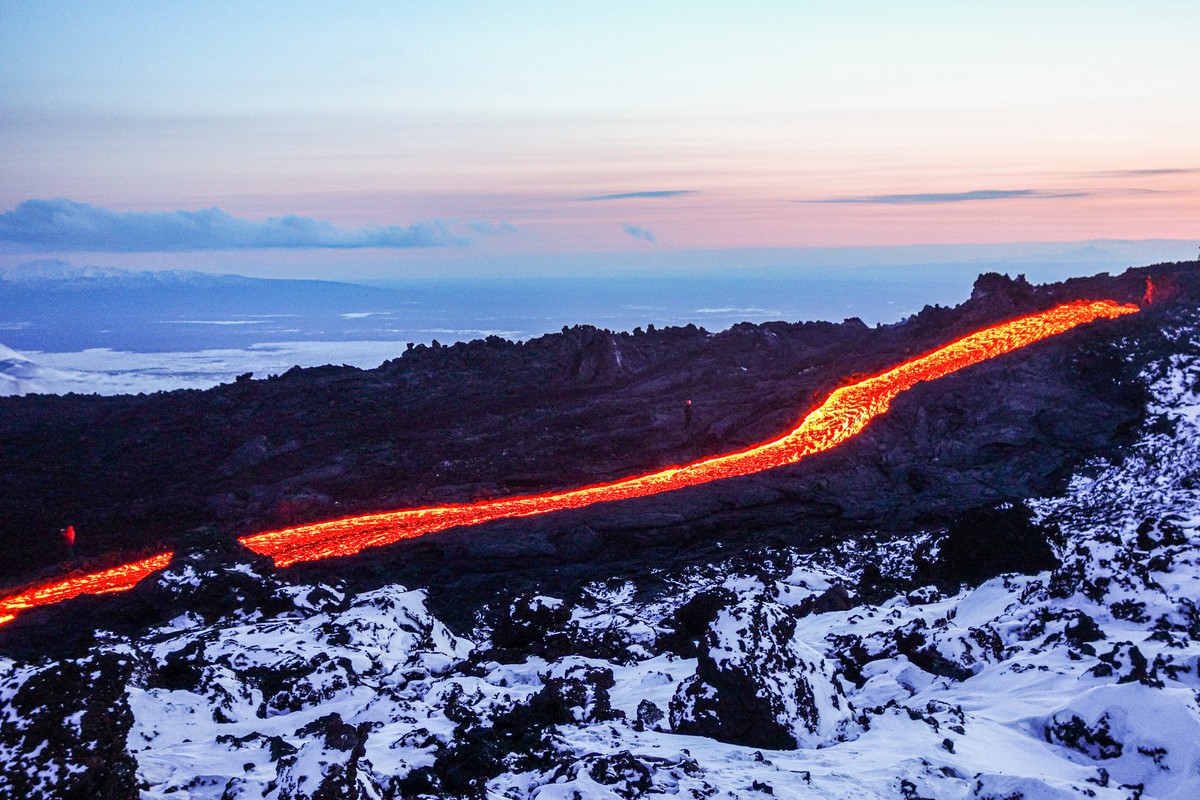
Sure, that’s a long river of lava, but it didn’t quite make it to the Sea of Okhotsk or the Pacific Ocean. It sure tried, mind!

And I was lucky enough to have been there at the time! I’ve written plenty about the experience, and shown plenty of photos too. Here, let me simply share the main emotions felt when surrounded by red hot lava…
Talking a stroll across these fields of rock with red rivers was great fun, especially across parts that had only just cooled and hardened. Your upper body is freezing (air temperature: around -20°C, but when the wind starts to blow up – oh my ghastly!), while your legs are as warm as freshly-baked bread – and your boots: melting. Literally!…
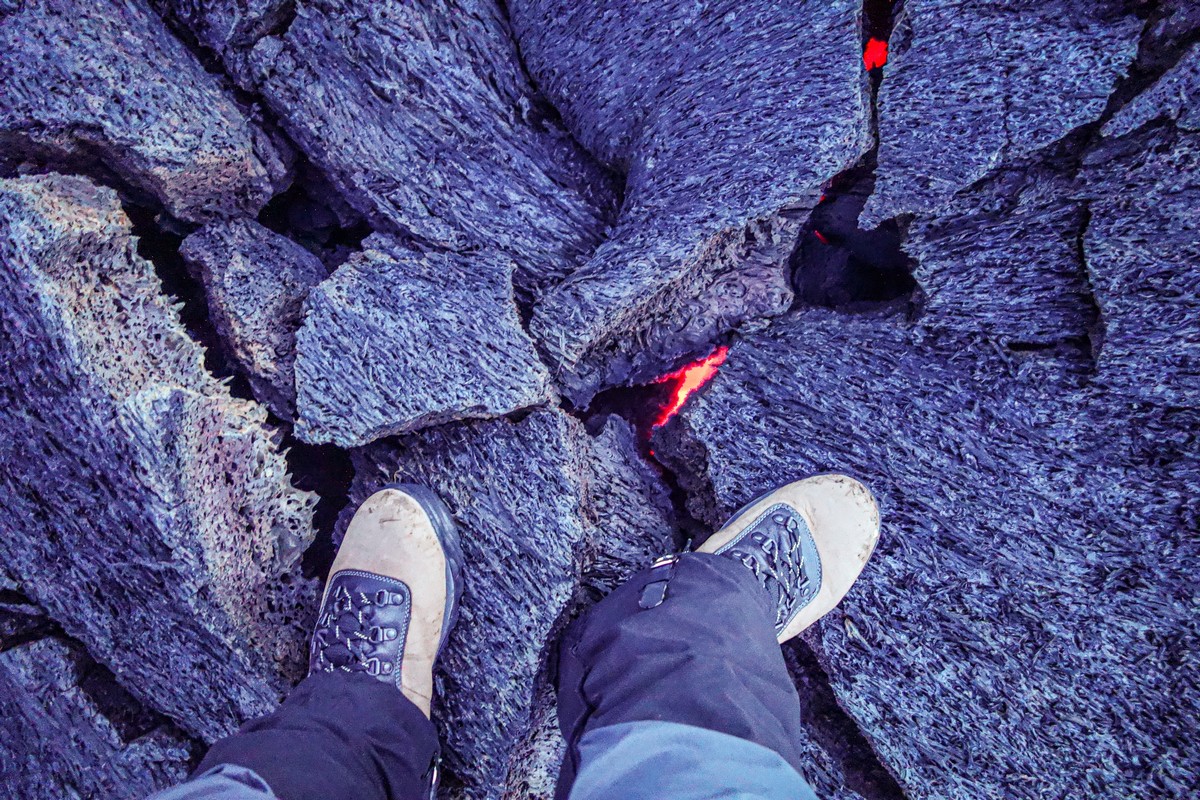
It’s best to go walkabout on the lava fields and check out the red rivers at night, or at least dawn or dusk. Then the colors are brighter, the contrasts – sharper:
By day there’s practically nothing to be seen that’s brightly colored. Lava splashes aren’t bright red (like at night) but somehow black! ->
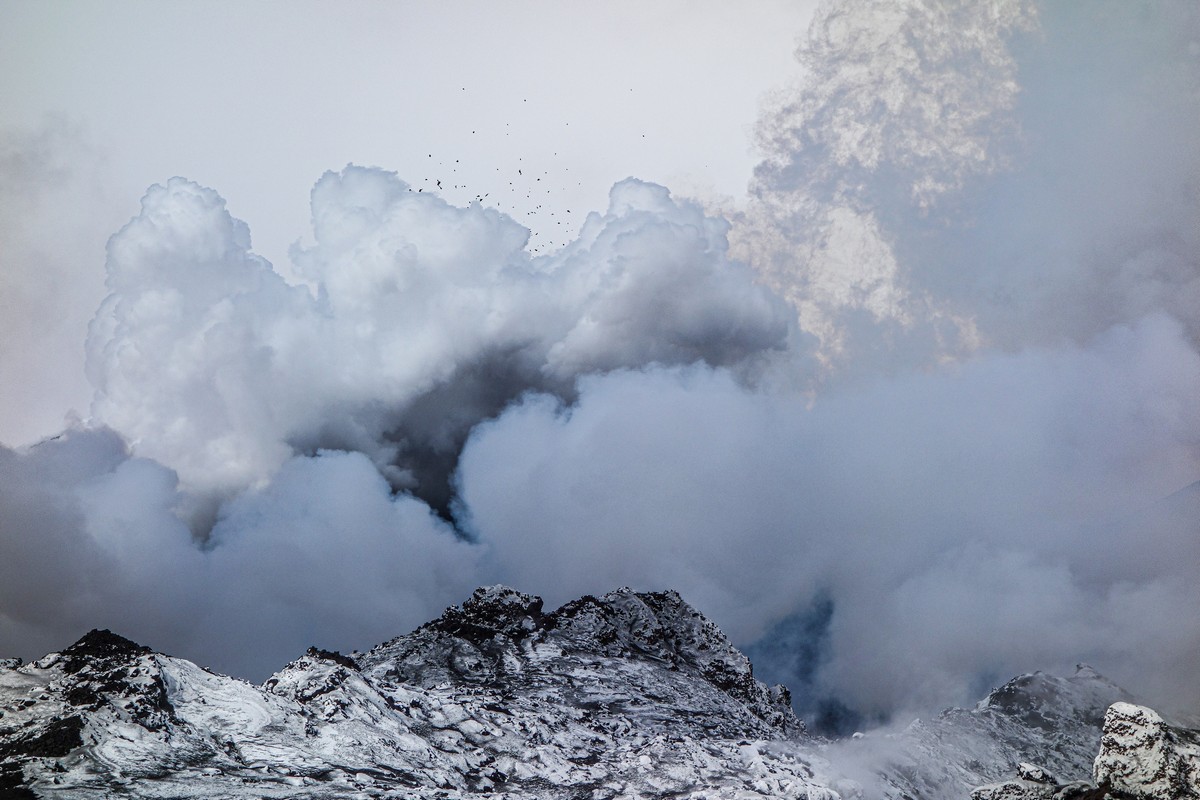
The lava rivers, too, are duller by day (still OMG-awesome though:) ->
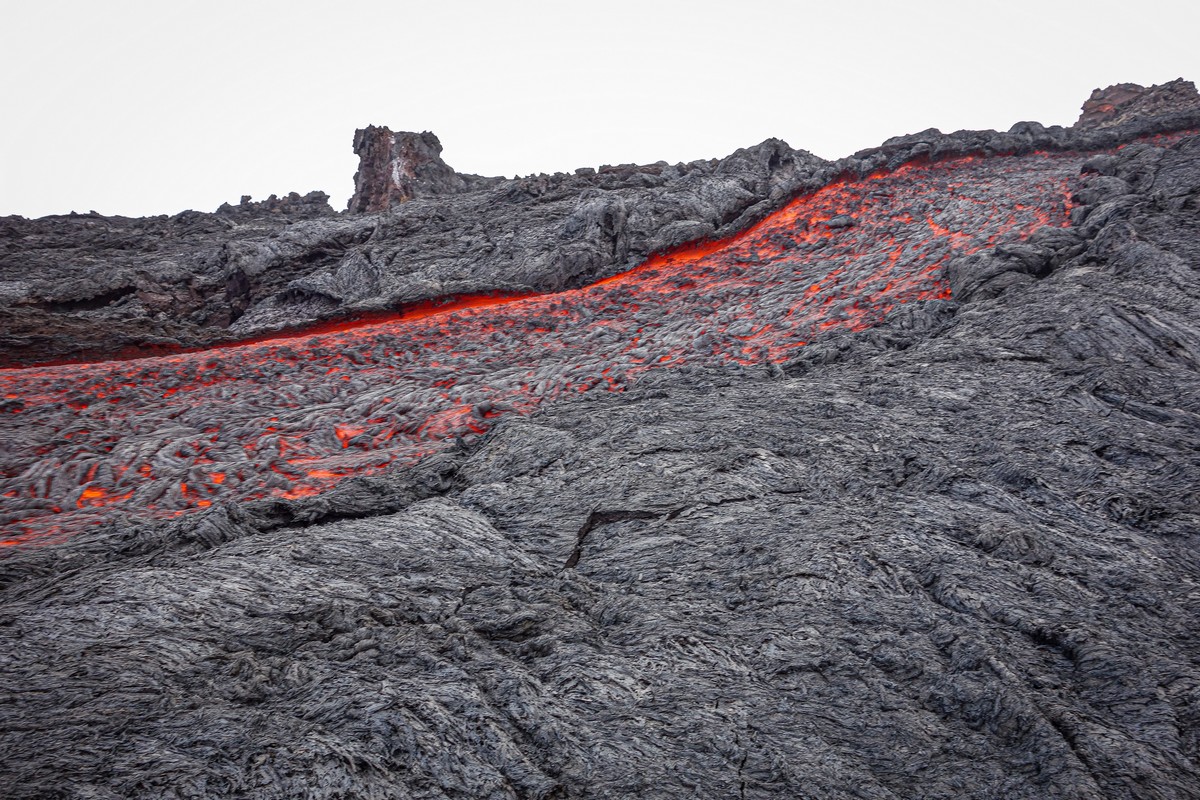
The sounds to be heard are strange totally alien scraping and rustling sounds. The smells, too – utterly bizarre; dry, chemically. Not pungent smells, just thoroughly odd ones!
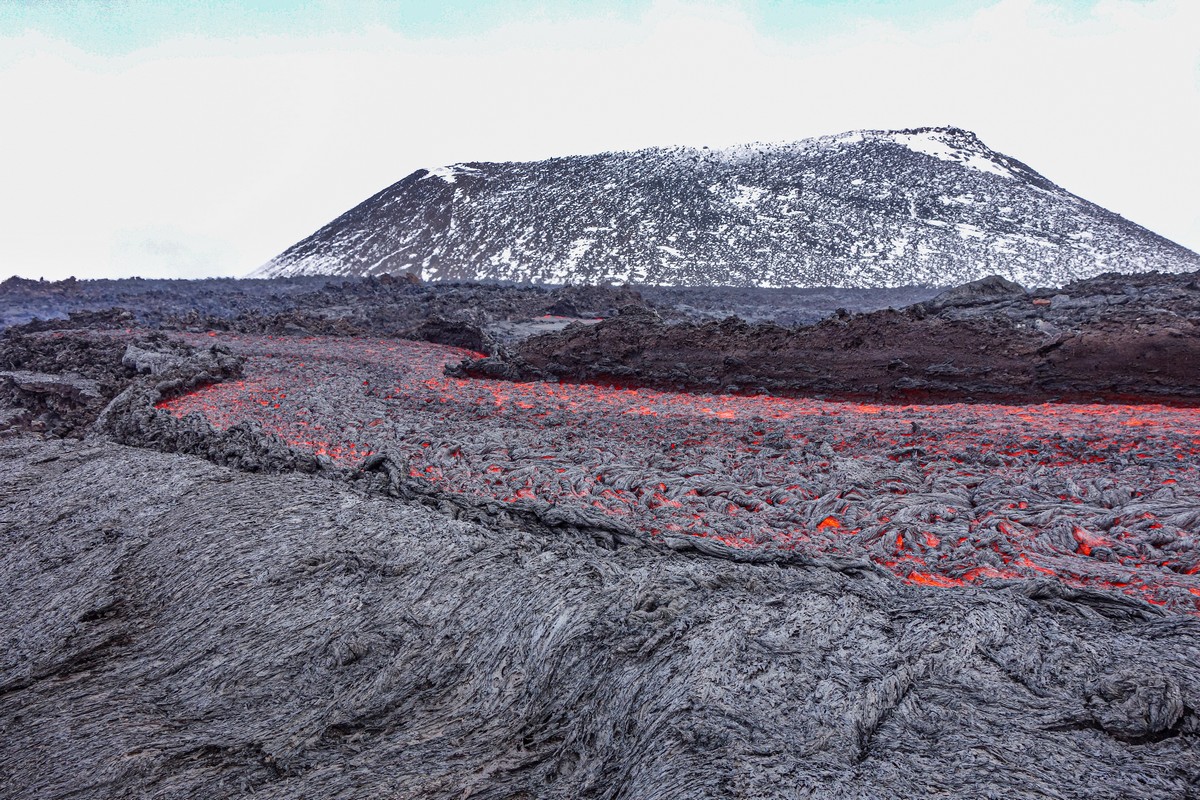
You can only get two or three meters from these here ‘rapids’. To get any nearer you need special protective clothing. Otherwise, regular civvies simply start to melt. After all, the temperature of the liquid rock is… 800°C or hotter!
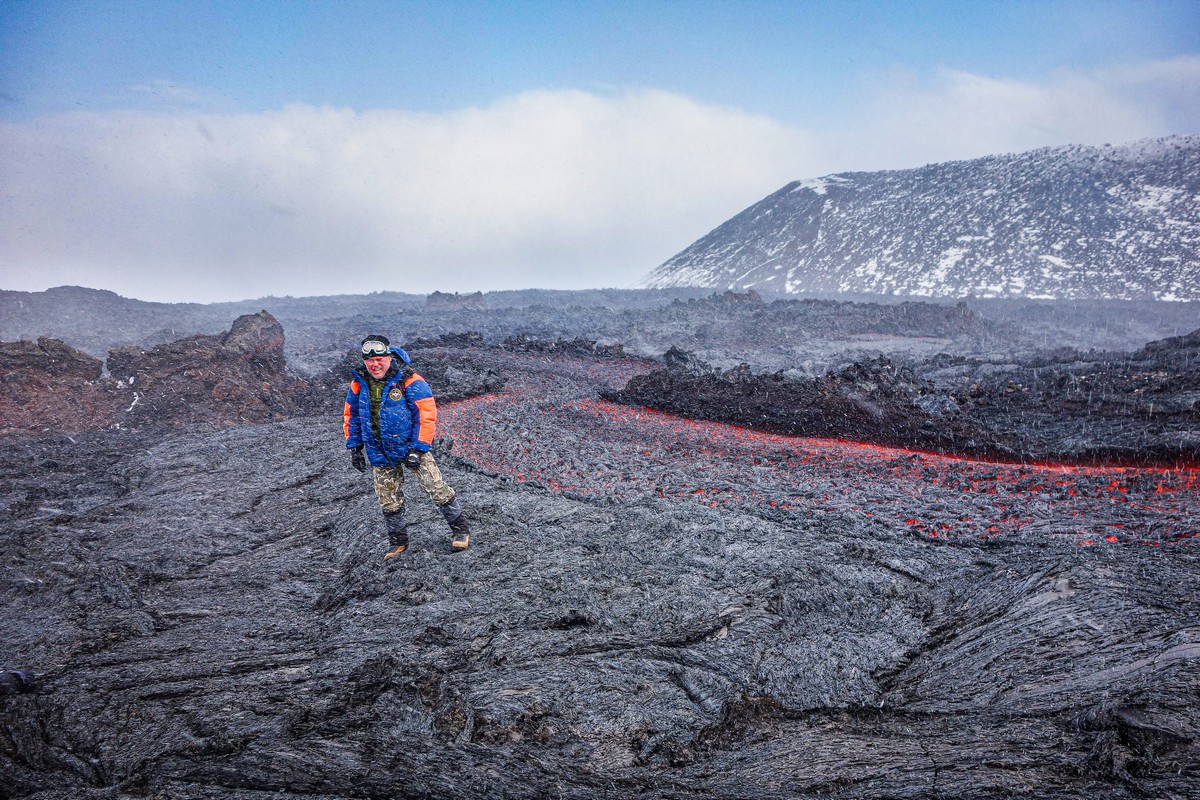
It flows pretty fast – around 5km/h…
Look at that! In a word: sublime!
If you really want to – and you’ve a pole long enough – you can fish out some molten lava! ->
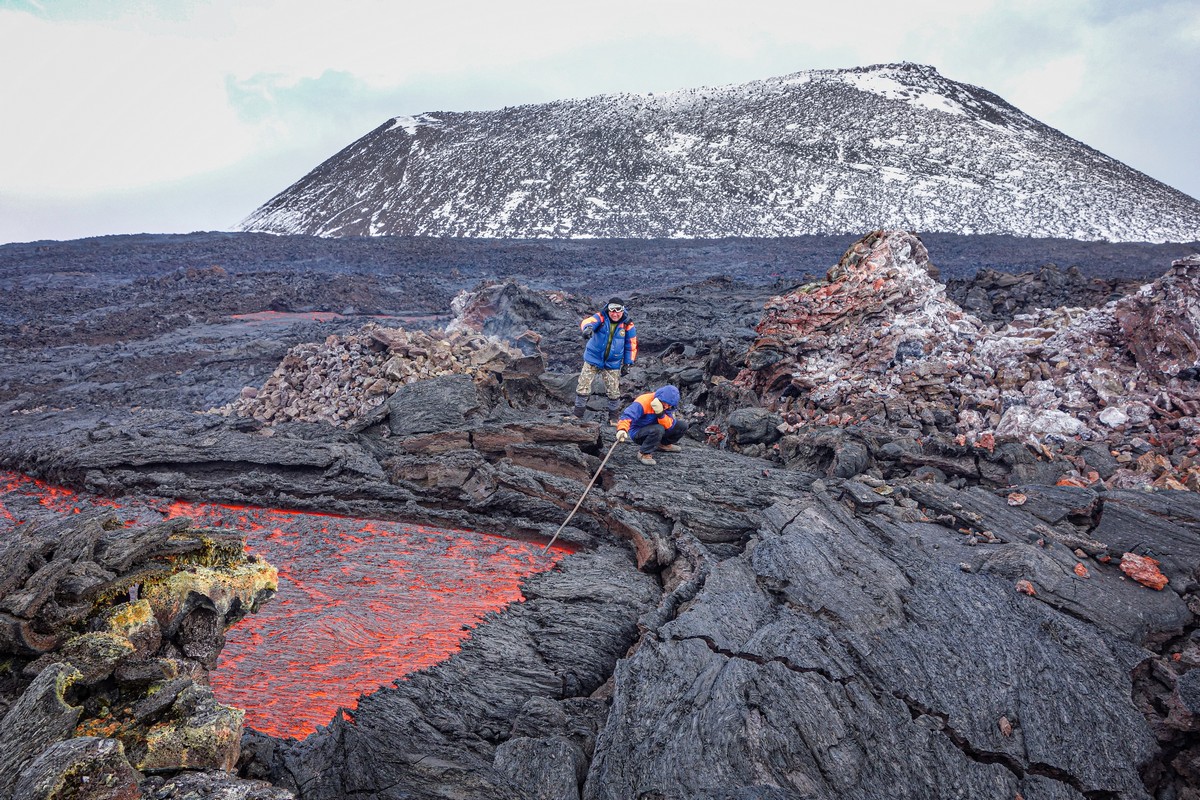
Then, while still hot, you can make a sculpture of some kind. Like a coin. Or a coin in a rock! Or you could…
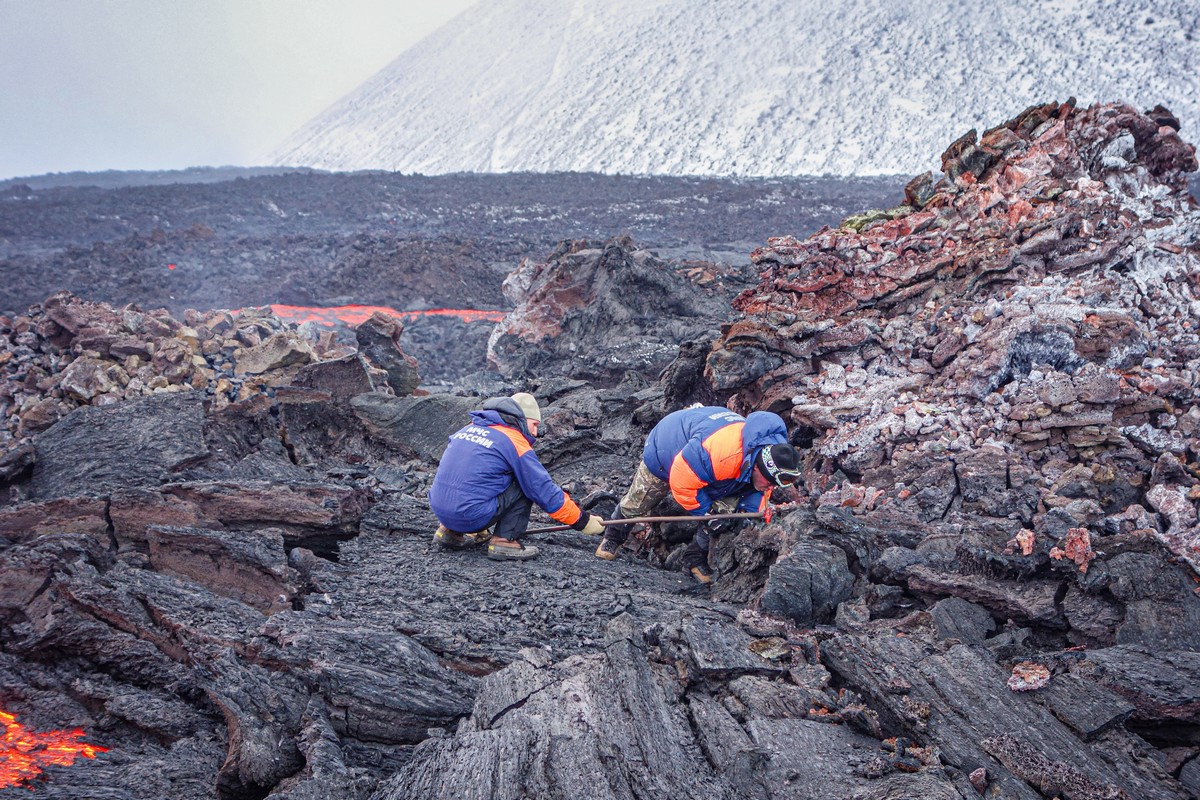
Light your Cohiba on it ).

Lava river, all around – snow and ice. Infernal!
Active crater. We’ll come back to it a bit later…
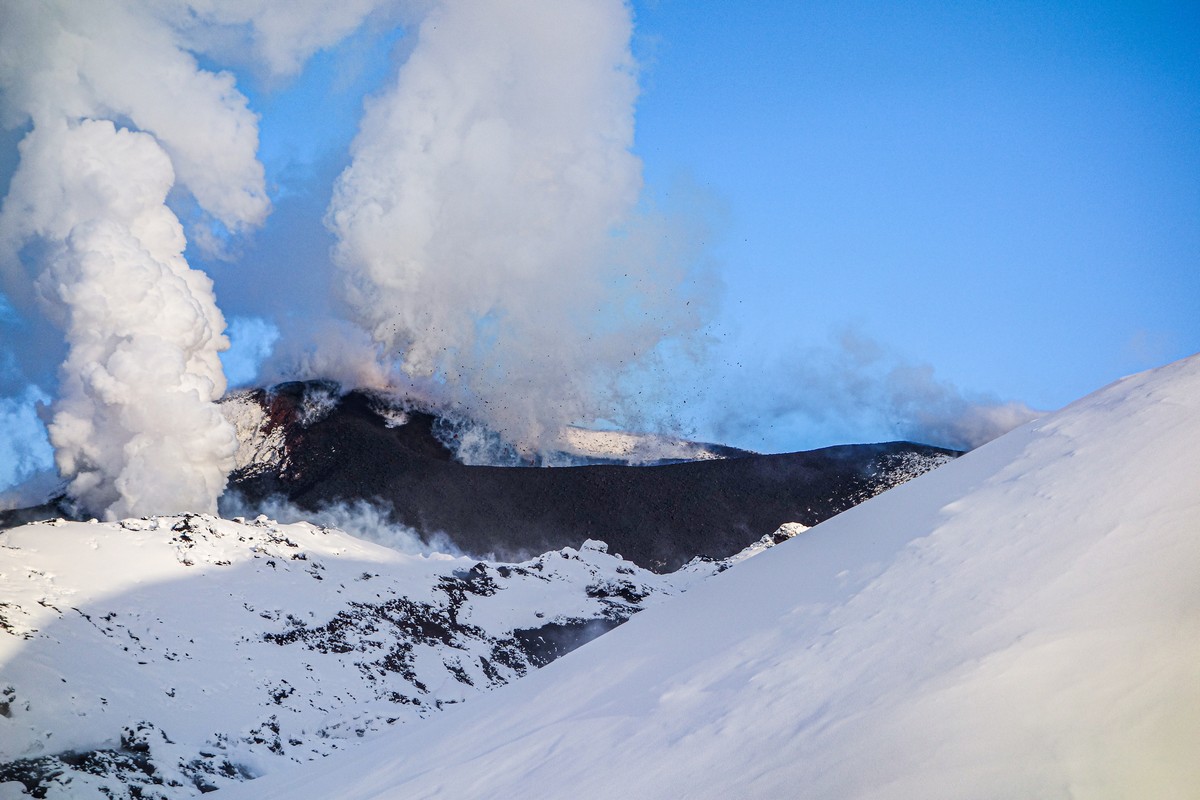
And this is how the rest of the Northern Fissure looked in April 2013, a result of the 1975 eruption:
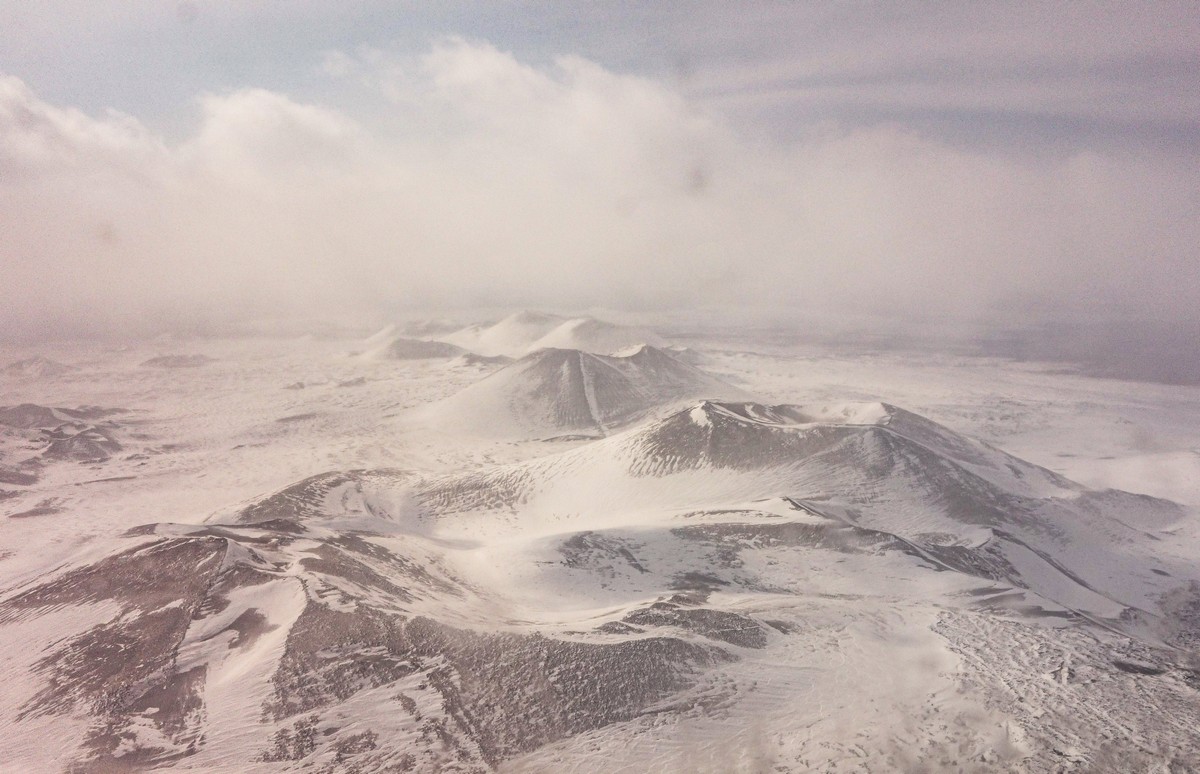
And now a few photos taken by another Kamchatka fan, A.B. ->
Eruption ended, crater stopped gurgling, lava cooled – and all around now these here lava fields ->
Modern lava-kunst:
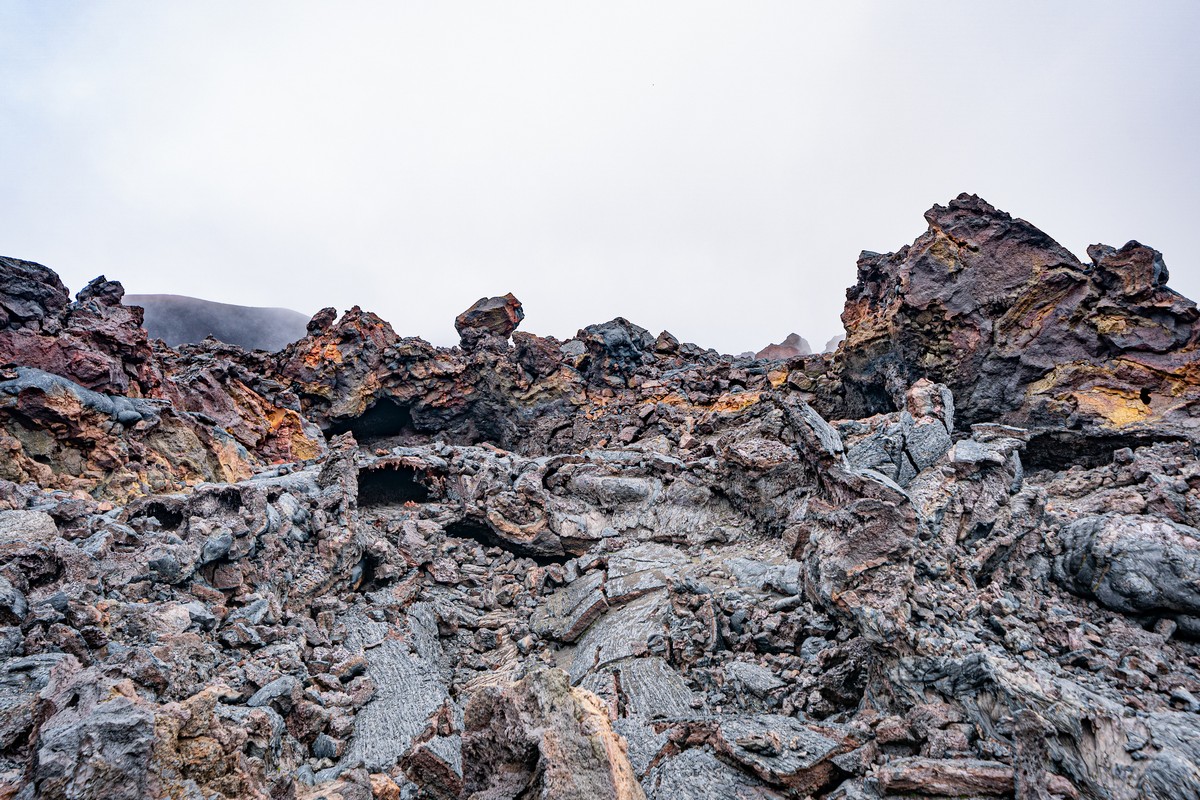
Lava rivers gradually cool, get covered with a hard ‘skin’, under which still flows liquid lava, forming lava tunnels. The process it repeated over and over with fresh lava, the liquid lava flows out, not-so liquid lava hardens, and then you get caves and tunnels:
In some tunnels the volcanic activity is still going on not far away underneath – heating the caves to make a lava banya! I think that they even call them steam caves…
Active crater, 2012-13:
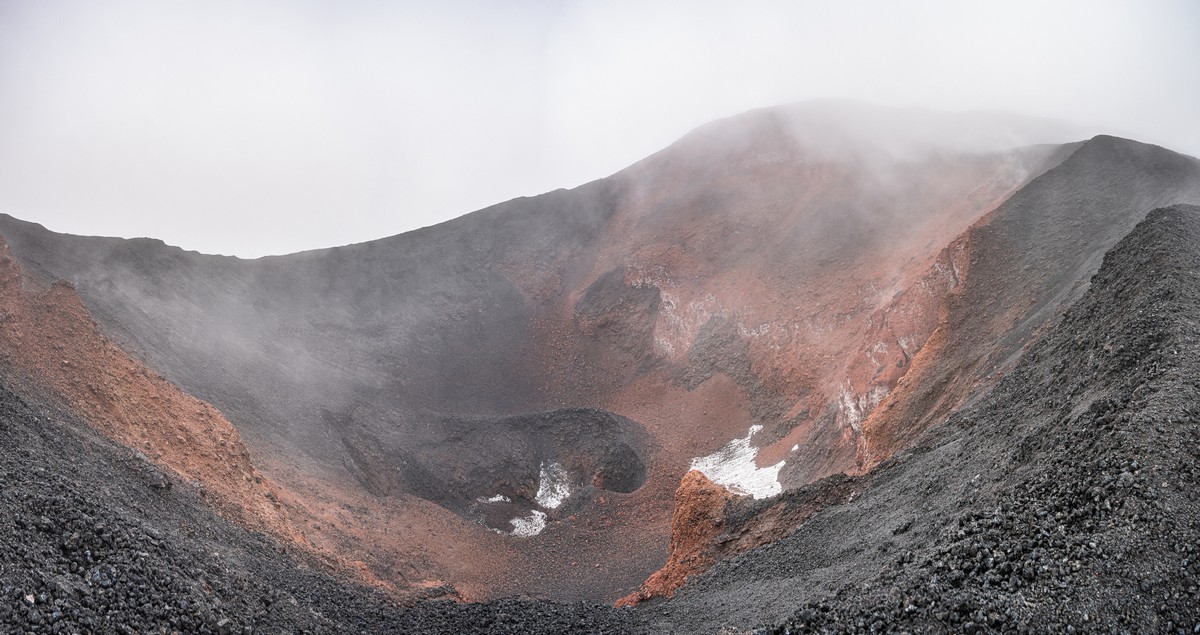
Aftermath. What things look like after an eruption. Not quite so glamorous as during one ) ->
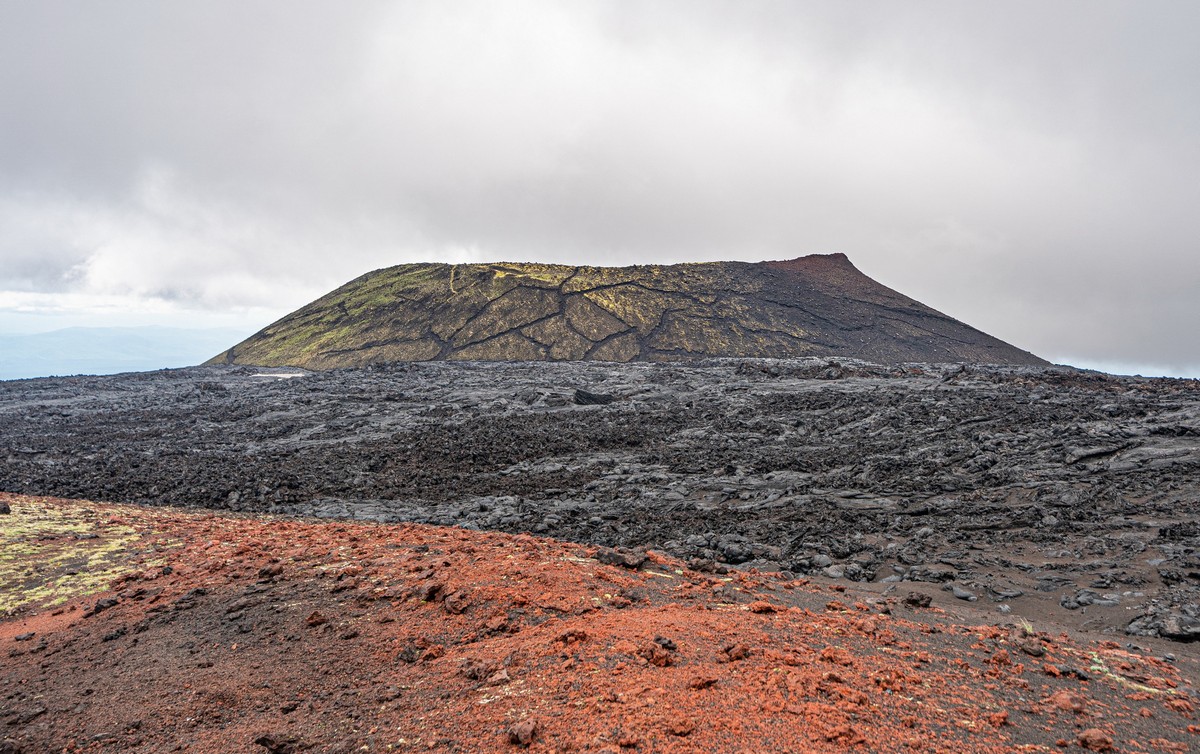
And that’s all from Tolbachik for now folks. There’s more coming up, but not quite from Tolbachik itself; more like the its surrounding areas. Stay tuned!…
All the pics from Kamchatka-2021 are here.




























